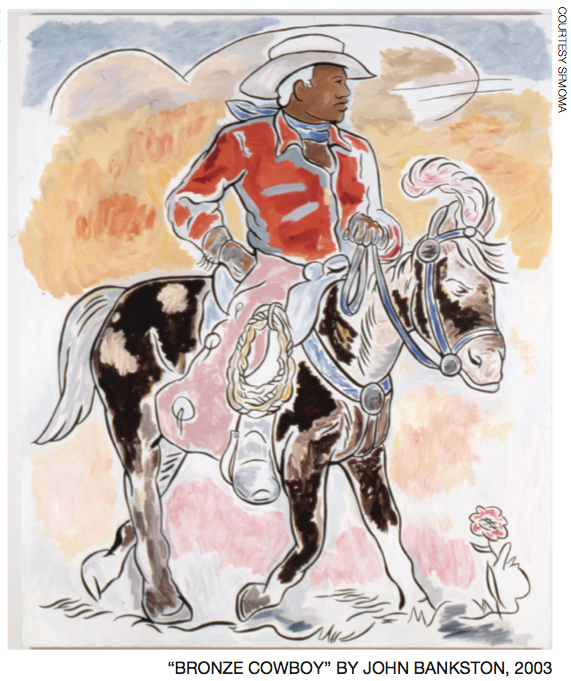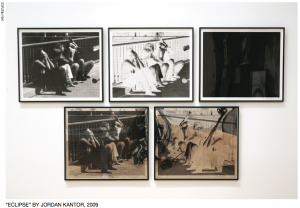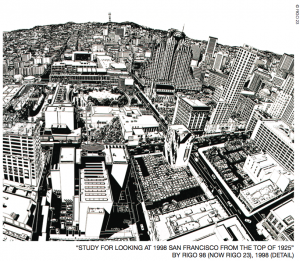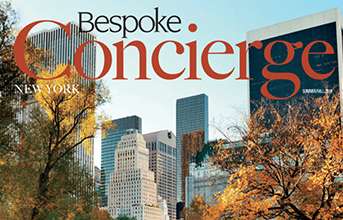Celebrating 50 Years of Art
The San Francisco Museum of Modern Art presents a half-century of award-winning contemporary artists.
By Tiffany Carboni
Nineteen thirty-five was a formative year for the United States. As the Depression took its toll, the Dust Bowl wreaked havoc and another world war loomed ahead, the country persevered, creating many firsts that would define American culture in more uplifting ways for decades to come.
Just as it ushered in the Sugar and Orange Bowls, canned beer and the passing of the Social Security Act, 1935 welcomed the San Francisco Museum of Modern Art as the first museum on the West Coast devoted to modern and contemporary art.
From the beginning, SFMOMA championed the most innovative and challenging art of its time, and continues to exhibit work by both modern masters and emerging artists. Today, the collections include more than 27,000 works of photography, painting and sculpture, architecture and design, and media arts representing key examples of both Modernism and more recent works reflecting a variety of artistic developments from around the world.
A council of SFMOMA supporters founded a collector’s club in 1961, dedicated to educating its members about the most current art practices and helping the museum bring the newest art into the collection. Known as the Society for the Encouragement of Contemporary Art (SECA), the group hit the ground running, organizing national survey exhibitions through 1966 that included the cutting-edge work of key Bay Area artists such as Nathan Oliveira, Peter Voulkos and William T. Wiley.
The group established the SECA Art Award in 1967, which has become the group’s most visible initiative and remains one of the few and longest-running award exhibition programs dedicated to local artists at a modern art museum in the United States. “The SECA Awards began as a way to celebrate and promote Bay Area artists, allowing them a platform they couldn’t otherwise acquire on their own,” explains Alison Gass, SFMOMA’s assistant curator of painting and sculpture.
Finding high-quality contemporary artists comes naturally to the group, which has served as the museum’s liaison to the artist community through the years by regularly organizing educational opportunities and meeting with artists, gallerists, collectors and curators. While the group has access to all these channels, identifying an artist eligible for the award involves much more than judging an individual’s body of work. The biennial award process spans a year that begins with nominations of artists who are at a relatively early stage in their careers but have a solid footing in contemporary art.
From that list of nominations, 30 finalists are selected. The curators and SECA members then visit those artists’ studios in order to get a better understanding of not just what they create but how they go about doing so, Gass explains. “The award goes to the artists who are working at a high level and are truly ready for the exposure. We are honored by how seriously the artists take this process. It’s a reminder of how much contemporary art there is right here in the Bay Area. And thanks to this award, the public gets an opportunity see more of it.”
The final decision is made by two (of the 20 or so) SFMOMA curators who rotate duties each competition. In the end, only up to four artists may win each year’s competition. Since its inception, the SECA Art Award program has recognized more than 70 winning artists and given hundreds of finalists a platform to speak about their practice.
The Exhibit
Through April 3, SFMOMA guests can take in the collection of 60 of the winners’ works in the “Fifty Years of Bay Area Art” exhibit. Organized by Gass and the assistant curator of media arts, Tanya Zimbardo, the exhibit includes various media created between the 1960s and present day. “When we started to cull the material, we began to see that there were nice through-lines, even dialog between different artists spanning different generations,” Zimbardo says. “Though we’ve seen many changes in contemporary art in the Bay Area since the ’60s, there is a close sense of community in the Bay Area art world and through the artists themselves that becomes apparent in the exhibit.”
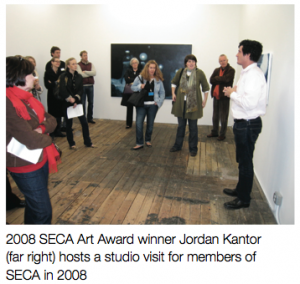 “Bay Area art is not and has never been one art, but there have been movements,” Gass adds. “Because the exhibit is organized thematically, it becomes obvious there are so many things happening in the Bay Area that reflect the larger picture of what’s happening to contemporary art in general. There are trends and themes, but what makes this exhibit so interesting is the different stories behind each piece.”
“Bay Area art is not and has never been one art, but there have been movements,” Gass adds. “Because the exhibit is organized thematically, it becomes obvious there are so many things happening in the Bay Area that reflect the larger picture of what’s happening to contemporary art in general. There are trends and themes, but what makes this exhibit so interesting is the different stories behind each piece.”
Because the exhibit is arranged thematically rather than chronologically, the presentation reflects on loose clusters of works, identifying affinities among the artists and commonalities over the program’s last five decades. The exhibition begins with a broad focus on place, marked by a narrower focus on the Bay Area. Works such as Bonnie Ora Sherk’s and Howard Levine’s temporary offsite portable parks (1970), Amy Franceschini’s citywide victory garden program (2006), and Rigo 23’s panoramic view of the redevelopment of South of Market area (1998) examine how SECA artists have responded to the their urban landscape. The landscape genre is further explored in works by Leslie Shows (2006) and Trevor Paglen (2008).
A gallery devoted to intimate-scaled works on paper includes documentation of Wayne E. Campbell’s 1971 SECA exhibition, in which he invited another man by the same name to exhibit instruction-based paintings and drawings alongside his own. Minimalism in sculpture practice and the use of quotidian materials link sculptures by John Beech (1992), Gay Outlaw (1998) and Mitzi Pederson (2006).
Abstract painting is explored with the pattern- based inquiries of Tauba Auerbach (2008) and the monochrome paintings of Anne Appleby (1996) and John Meyer (1990) to the meditative works of Laurie Reid (1998) and Kathryn Van Dyke (2000). Reflections on personal mythology and shared American cultural references arise in the work of William Allan (1969), John Bankston (2002), David Best (1977) and Desirée Holman (2008). And examinations of art making in a digital era weave through works by Jim Campbell (1996), Kota Ezawa (2006), Chris Finley (1998) and Jordan Kantor (2008).
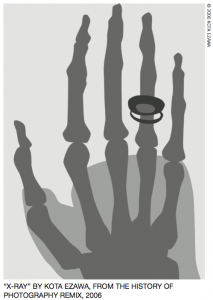 “In an era when many museums are becoming increasingly community-centered, initiatives like SECA can be looked to as a model,” Gass says. “It has consistently helped bridge the activities happening within the museum’s walls and the changing culture beyond them. SFMOMA brings art in from everywhere to inspire the artists working here, but it’s equally important for local artists to see their work in dialogue with history as well. SECA ensures that this continues to happen.”
“In an era when many museums are becoming increasingly community-centered, initiatives like SECA can be looked to as a model,” Gass says. “It has consistently helped bridge the activities happening within the museum’s walls and the changing culture beyond them. SFMOMA brings art in from everywhere to inspire the artists working here, but it’s equally important for local artists to see their work in dialogue with history as well. SECA ensures that this continues to happen.”
Since its formation, SECA has recognized an incredible amount of local artists, affording their work broader critical attention, both within and outside the museum, than they may have received on their own. Additionally, SECA has introduced these great artists to the museum’s international audience.
The Artists
SECA award winners tend to have significant relationships with SFMOMA long after the pomp and circumstance. Kamau Amu Patton, a 2010 award winner whose sculpture is featured in the current exhibit, looks forward to continuing his relationship with the museum and the Bay Area art community.
Based both in New York and San Francisco, Patton received his MFA from Stanford University in 2007. Although he divides his time between the two coasts, Patton has had a strong affinity with the Bay Area made even stronger with this award. “Even though I’m from New York, the majority of my career as an artist involves the Bay Area. I’ve lived and worked in the Bay Area for 15 years. However, because I’m constantly traveling back and forth to New York, there was a feeling of being dislocated from either area,” he says. “Winning this award and being a part of SFMOMA show has solidified my sense of place and where my artistic lineage resides.”
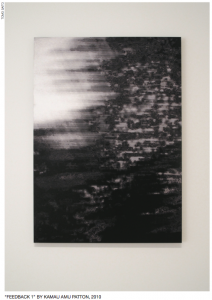 As the year 1935 offered our culture many firsts, so too does SFMOMA and SECA. By seeking out the talented, but not wholly discovered contemporary artists working in the Bay Area, the museum and the dedicated club offer an incredible platform to showcase the works of these local artists to international art lovers who are ready to receive them.
As the year 1935 offered our culture many firsts, so too does SFMOMA and SECA. By seeking out the talented, but not wholly discovered contemporary artists working in the Bay Area, the museum and the dedicated club offer an incredible platform to showcase the works of these local artists to international art lovers who are ready to receive them.
THE BOOK
The “Fifty Years of Bay Area Art” exhibit stems from the 15th anniversary book of the same title edited by Alison Gass and Tanya Zimbardo. The publication, available at SFMOMA, offers the full scope of the SECA Awards as well as the story of SECA’s layered development and the many educational activities it has sponsored.
Whereas the exhibition features selected past award recipients, the book by Gass and Zimbardo represents all SECA artists from 1967 through 2010, arranged by award year and accompanied by a work or installation view from their respective award exhibition.
SFMOMA
151 Third St.; 415-357-4000; sfmoma.org; Admission: $18; Hours: Monday – Tuesday, 11 a.m. – 5:45 p.m.; Thursday, 11 a.m. – 8:45 p.m.; Friday – Sunday 11a.m. – 5:45 p.m.; closed Wednesdays.

